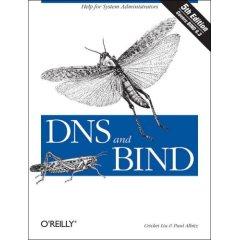| 2020ok Directory of FREE Online Books and FREE eBooks |
Free eBooks > Computers & Internet > Networking > Data in the Enterprise > Client-Server Systems > DNS and BIND
DNS and BINDby Cricket Liu and Paul Albitz  Download Book (Respecting the intellectual property of others is utmost important to us, we make every effort to make sure we only link to legitimate sites, such as those sites owned by authors and publishers. If you have any questions about these links, please contact us.) link 1 link 2 link 3 About Book Amazon.com This is the definitive book on the Domain Name System (DNS), the powerful scheme that facilitates the translation of English-like domain names (www.amazon.com) into computer-comprehensible Internet Protocol (IP) addresses (208.216.182.15). If you run a DNS server of any kind, particularly under Unix, you need to have this book on hand. This book's early chapters give a view of DNS from high altitude, explaining basic concepts such as domains, name servers, and name resolution. From there, the authors proceed on a more practical tack, presenting specific instructions for setting up your own domain and DNS server using BIND. The authors then tell you what to do as your domain grows and you need to add more machines, subdomains, and greater throughput capacity. They also talk a lot about nslookup and C programming with the various DNS and BIND libraries. Administrators will find the chapter on BIND debugging output particularly helpful. Here, the authors translate BIND's mysterious error messages and offer specific strategies for fixing and optimizing the program. This edition covers BIND 8.1.2, but pays lots of attention to older versions that are still in wide use (4.8.3 and 4.9). The authors are careful to note differences among the versions. --David Wall
DNS and BIND tells you everything you need to work with one of the Internet's fundamental building blocks: the distributed host information database that's responsible for translating names into addresses, routing mail to its proper destination, and even listing phone numbers with the new ENUM standard. This book brings you up-to-date with the latest changes in this crucial service. The fifth edition covers BIND 9.3.2, the most recent release of the BIND 9 series, as well as BIND 8.4.7. BIND 9.3.2 contains further improvements in security and IPv6 support, and important new features such as internationalized domain names, ENUM (electronic numbering), and SPF (the Sender Policy Framework). Whether you're an administrator involved with DNS on a daily basis or a user who wants to be more informed about the Internet and how it works, you'll find that this book is essential reading. Topics include:
Book Info Discusses one of the Internet's fundamental building blocks: the distributed host information database that's responsible for translating names into addresses, routing mail to its proper destination, & many other services. Paper. The publisher, O'Reilly and Associates This book is a complete guide to the Internet's Domain Name System (DNS) and the Berkeley Internet Name Domain (BIND) software, the UNIX implementation of DNS. In this second edition, the authors continue to describe BIND version 4.8.3, which is included in most vendor implementations today. In addition, you'll find complete coverage of BIND 4.9.4, which in all probability will be adopted as the new standard in the near future. DNS is the system that translates hostnames (like "rock.ora.com") into Internet addresses (like 192.54.67.23). Until BIND was developed, name translation was based on a "host table"; if you were on the Internet, you got a table that listed all the systems connected to the Net and their addresses. As the Internet grew from hundreds to hundreds of thousands of systems, host tables became unworkable. DNS is a distributed database that solves the same problem effectively, allowing the Net to grow without constraints. Rather than having a central table that gets distributed to every system on the Net, it allows local administrators to assign their own hostnames and addresses and install these names in a local database. This database is automatically distributed to other systems as names are needed. In addition to covering the basic motivation behind DNS and how to set up the BIND software, this book covers many more advanced topics, including using DNS and BIND on Windows NT systems; how to become a "parent" (i.e., "delegate" the ability to assign names to someone else); how to use DNS to set up mail forwarding correctly; debugging and troubleshooting; and programming. Assumes a basic knowledge of system administration and network management. Related Free eBooks
| Related Tags |












partner kennenlernen, 2010-03-30 13:03:47
SEND A COMMENT
PLEASE READ: All comments must be approved before appearing in the thread; time and space constraints prevent all comments from appearing. We will only approve comments that are directly related to the article, use appropriate language and are not attacking the comments of others.